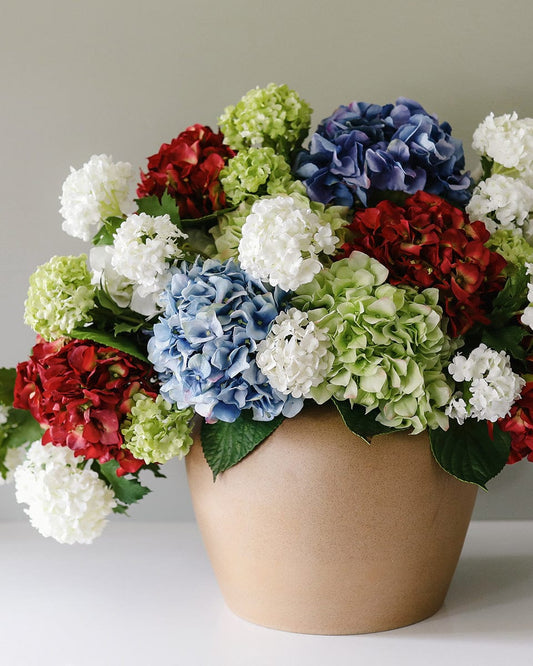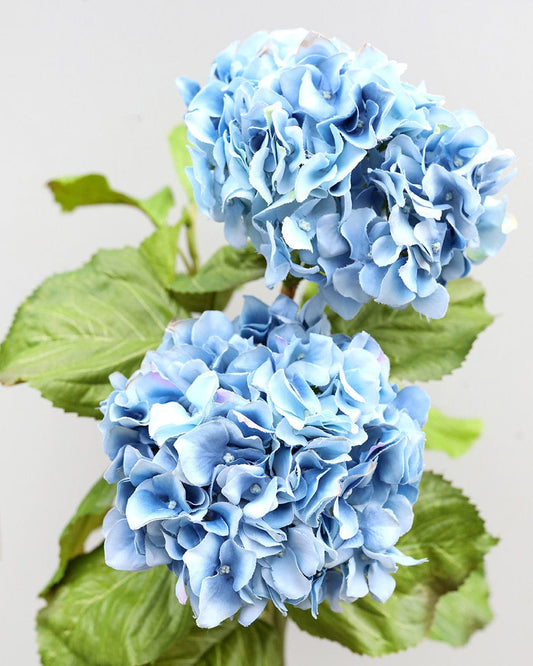Blue Hydrangeas Without the Blues: Choosing Perfect Artificial Blue Hydrangeas

I’m staring at two blue hydrangea heads on my desk and can’t decide if one is actually bluer or if the overhead bulb is lying to me. Maybe it’s the 4000K light. Maybe it’s just my eyes. Either way, this keeps happening: I put a “blue” bloom in a room and it either reads serene or weirdly icy. So if you’ve been burned by the wrong shade of faux blue before—same. Picking artificial blue hydrangeas isn’t about finding The Blue; it’s about choosing the undertone your room already likes. And yes, rooms have opinions.
Key Takeaways
- Pick undertone first (cool or warm-leaning blue), then pick scale. Your room already knows what it wants.
- Texture matters—matte or real-touch petals tame harsh light and keep blue from turning plastic-y.
- Use a white or cream head as a diffuser when your blues feel too loud.
- Leaves can ruin it; swap glossy leaves or dust with cornstarch to kill shine.
Choosing the Right Blue Hydrangea Undertone
Blue is trickier than people admit. It leans green, or it leans purple, and that tiny tilt decides if your arrangement feels calm, coastal, or oddly cold. I don’t know exactly why this works, but soft, dusty blues play nicely with warm woods; in crisp white rooms you can go cooler without it looking sad. The point isn’t perfection. It’s believable variation—like the way real hydrangeas shift as they age. When I’m starting from scratch, I still send folks to the full spread of artificial blue hydrangeas first, just to see the undertones side by side.
So here’s how I test undertone. I cluster three blues that aren’t identical, then I back up and squint. The one that hangs back becomes the base; the one that pops becomes the accent. If the whole thing looks flat, I add green foliage. If it looks electric, I add one off-white head to diffuse the color. None of this is technical. It works.
Texture, Light, and the “Shine Problem”
Lighting makes or breaks blue. Morning light cools it down; tungsten warms it up; some LEDs push it neon if the petals are too saturated. I keep one medium, one deep, and one airy blue stem on hand for “which one belongs here?” tests. Real hydrangeas have velvety petals that catch light softly. If the faux petals are too shiny, the whole blue reads plastic-y (technical term). Matte or real-touch finishes help.
I was playing with a tall hallway arrangement and needed drama without going shouty, so I grabbed the double-bloom blue stem I use when one piece needs to do the heavy lifting. The scale just helps.


Blue Double Hydrangea 36"
Bent this a touch to tilt the top head forward—held shape without the stiff, mannequin look. In shade it reads medium-deep with a hint of slate.
That little slate cast saves it from looking toy-ish under cool LEDs. Also, the second head lets you cheat volume without hunting for pairings. Not subtle, but it lands.
And texture again. I keep a softer “real touch” stem around for when I want the bloom to sit closer to matte. I grabbed my 28.5-inch real-touch blue yesterday to test it against the one above because the undertone is a smidge moodier—good for rooms with gray fabric sofas that swallow lighter blues.


Real Touch Blue Hydrangea 28.5"
Feels soft, diffuses light cleanly. The edges pick up a faint violet late day—reads deeper without going navy.
Once you get texture right, your blue stops fighting your lamps. That’s half the battle.
Scale, Clustering, and Where the Eye Rests
Yesterday I was comparing a deeper blue against a softer periwinkle on a walnut console and realized the bigger, fluffier heads win when the backdrop is busy. More surface area averages the color. Smaller, tighter heads show undertone more honestly—good when you want clarity, bad when it fights the wall paint. Single big heads feel formal. Sprays or smaller heads feel casual. I’m not picking sides—match the room’s energy.
Undertone check, part two. I keep a lighter, 18-inch blue stem for coffee tables where tall stems feel fussy. This one leans periwinkle in daylight and settles into a quieter blue at night, which is usually what you want when the TV is on and everything else glows.
I pulled the short real-touch stem into a tray vignette with a stack of art books and noticed it didn’t glare—some blues do. It just sat there and took the light well.


Real Touch Blue Hydrangea 18”
Sits low without looking stubby. I nudged two petals open with my thumb—relaxed the shape and it read more lived-in.
Two quick guiding ratios I actually use: on a coffee table, three medium heads in a low bowl feel easy. On a dining table, five to seven heads in a footed vase fill the space without blocking faces. For consoles, two tall doubles plus one small stem on the side balances height without looking staged.
Mixing Blues with Greens and Neutrals (and why it helps your brain)
Quick thought on psychology, because it shows up in living rooms whether we like it or not: blue calms, yes, but too much deep blue in a small room can flatten things emotionally. You know that “hotel lobby quiet”? That. I like a balance—two blues to one green to one neutral. And on days when your brain is buzzing, a cooler blue actually helps you focus. Place it near your work corner. Don’t overthink it.
One thing I’ve had to relearn: leaves matter more than we think. Blue bloom + shiny plastic leaves = the eye notices the wrong thing first. If your leaves glare, the bloom loses all its quiet.
So I grabbed a leaf spray to swap into a bundle because the original leaves were too glossy, and I wanted that soft, velvety green you get outdoors.


Hydrangea Leaf Faux Foliage 20"
Swapped a couple stems in—matte enough that the blue reads first. The veining looks irregular, which helps.
If you already bought a stem with shiny leaves (we’ve all done it), dust a makeup brush with cornstarch and tap-tap-tap it over the leaves, then wipe the excess. Kills the glare. Wait, I meant—don’t overdo it or it’ll look chalky.
If you’re mixing tones, check the main gallery of faux hydrangeas so you can pair a cool-leaning and a warm-leaning blue that still make sense together. And yes, neutral helps. I popped a white head into a mixed blue bundle to prove it to a friend who swore “blue on blue only.” It calmed the whole thing down.
Two quick opinions while I’m here: 1) Cheap bright blues almost never work in living spaces. They look great in party photos and harsh in real life. 2) Mixing one slightly greenish blue with one lavender-leaning blue is not a crime. It’s how a lot of shrubs look by August.
If you need a sanity check, park your stems by a window and go make tea. Come back and look fast. First glance tells the truth. If it whispers “dentist office,” you need warmth—wood, brass, or a cream accent. If it says “beach rental,” you probably went too pale. Swap in one deeper head.
The Bottom Line on Artifical Blue Hydrangeas
Stop second-guessing. Every room has its perfect blue—you just need to trust your gut. Start with the artificial hydrangeas collection to see all your options at once. Pick the one that makes you pause. Buy it. Place it. If it works, you're done.
If it doesn't, you've learned what your space actually wants. Either way, you're ahead of where you started. The only mistake is buying nothing while waiting for perfection.
To choose artificial blue hydrangeas:
- Identify your room's undertone (warm or cool)
- Select matte or real-touch textures over glossy
- Test under your actual lighting conditions
- Mix 2 blues with 1 green and 1 neutral
- Choose scale based on space (18" for tables, 36" for floors)
If this sounded like a lot, it’s really just: test three, squint, adjust. Then enjoy the quiet that blue brings when it’s behaving.
Frequently Asked Questions
What undertone of blue hydrangea works best in warm-toned rooms?
Soft, dusty blues with subtle purple undertones complement warm woods beautifully. These muted tones prevent the arrangement from looking too cold against warm backgrounds.
How do I stop artificial blue hydrangeas from looking plastic?
Choose matte or real-touch finishes over glossy petals. If your stems have shiny leaves, dust them lightly with cornstarch using a makeup brush to reduce glare.
What's the ideal ratio for mixing blue hydrangeas with other colors?
Use a 2:1:1 ratio - two blue hydrangeas to one green foliage to one neutral (white or cream). This creates visual balance without overwhelming the space.
How many artificial hydrangea stems do I need for different spaces?
Coffee table: 3 medium heads in a low bowl
Dining table: 5-7 heads in a footed vase
Console table: 2 tall doubles plus 1 small accent stem
Why do my blue hydrangeas look different under various lights?
Morning light cools blues down, tungsten bulbs warm them up, and some LEDs can push saturated petals toward neon. Test your arrangement under the actual lighting conditions where it will be displayed.
Can I mix different shades of blue hydrangeas together?
Yes! Mixing one greenish-blue with one lavender-leaning blue creates natural variation. Use the squint test - the receding color becomes your base, the popping one your accent.
How do I make artificial hydrangeas look more realistic?
Bend the main wire just above the head for a 5-10 degree tilt. Real hydrangeas rarely face straight up, and this subtle angle makes them appear more natural and expensive.
What's the best artificial hydrangea size for small spaces?
For coffee tables and small surfaces, choose 18-inch stems. They provide presence without overwhelming the space or blocking sightlines during conversation.
Brighten Up You Room With Blue Hydrangeas!
Shop our stunning collection of artificial hydrangeas. Beautiful colors, beautiful blooms.
Shop Artificial Hydrangeas Now









